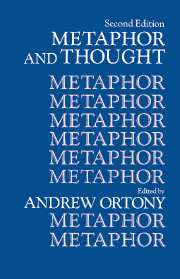Book contents
- Frontmatter
- Contents
- List of contributors
- Preface to the second edition
- Preface to the first edition
- 1 Metaphor, language, and thought
- METAPHOR AND MEANING
- METAPHOR AND REPRESENTATION
- METAPHOR AND UNDERSTANDING
- 14 Psychological processes in metaphor comprehension and memory
- 15 The interpretation of novel metaphors
- 16 The role of similarity in similes and metaphors
- 17 Images and models, similes and metaphors
- 18 How metaphors work
- 19 Metaphor and irony: Two levels of understanding
- METAPHOR AND SCIENCE
- METAPHOR AND EDUCATION
- References
- Author index
- Subject index
19 - Metaphor and irony: Two levels of understanding
Published online by Cambridge University Press: 05 June 2012
- Frontmatter
- Contents
- List of contributors
- Preface to the second edition
- Preface to the first edition
- 1 Metaphor, language, and thought
- METAPHOR AND MEANING
- METAPHOR AND REPRESENTATION
- METAPHOR AND UNDERSTANDING
- 14 Psychological processes in metaphor comprehension and memory
- 15 The interpretation of novel metaphors
- 16 The role of similarity in similes and metaphors
- 17 Images and models, similes and metaphors
- 18 How metaphors work
- 19 Metaphor and irony: Two levels of understanding
- METAPHOR AND SCIENCE
- METAPHOR AND EDUCATION
- References
- Author index
- Subject index
Summary
In defense of the literal–nonliteral distinction
Speakers often do not say what they mean. Both literal and nonliteral utterances require the listener to go beyond what is said to infer what is meant. Even the most literal of utterances is meant to convey unstated implications. To state (truthfully) that it is raining can mean not only that it is raining but also (depending on the context) (a) “Take your umbrella,” (b) “The picnic is off,” (c) “I told you so,” and so forth. Despite the fact that these meanings are unstated, they are usually effortlessly apprehended, and conversataion typically proceeds thereafter in seamless fashion. A multitude of cues enables the listener to infer what is meant.
Since in both literal and nonliteral discourse speakers invariably mean more than they say, the distinction between literal and nonliteral usage cannot rest on whether the speaker says what is meant. Instead, the distinction rests on the reverse – whether the speaker means what is said (Searle, this volume). In literal discourse, speakers mean what they say and more. In nonliteral discourse, speakers do not mean what they say. Hence, what is said must be used but discounted in the interpretation process.
In addition, the distinction between literal and nonliteral discourse in our view rests on the relation between what is said and what is meant. In literal utterances this relation is one of consonance: the implied meanings are consistent with the sentence meaning though they may range far afield from the actual statement, as in (b) and (c) above.
- Type
- Chapter
- Information
- Metaphor and Thought , pp. 425 - 444Publisher: Cambridge University PressPrint publication year: 1993
- 37
- Cited by



